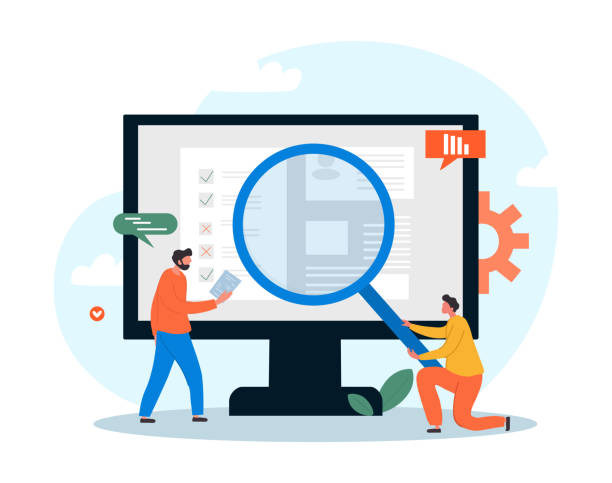The Initial Importance of a Successful Online Store

In the current era, which is accompanied by the increasing expansion of the internet and the digitalization of all aspects of life, having a strong online presence for any business, from the smallest shops to the largest companies, is no longer an option; rather, it is considered a vital necessity.
Meanwhile, e-commerce website design plays a pivotal role.
A professional e-commerce website is a gateway for your business to enter an endless market; a market not limited by geography or working hours.
By #building_an_online_store, you can offer your products and services to your customers at any time of day or night and from anywhere in the world.
This means achieving #global_reach and a significant increase in sales potential.
Furthermore, an efficient e-commerce site allows you to reduce #operational_costs and automate sales processes.
No longer is there a need to pay heavy rent for a physical store or hire a large number of sales personnel.
A website can single-handedly manage hundreds or thousands of customers simultaneously.
Investing in e-commerce website design is not only about modernizing your business but also a solid step towards achieving #high_competitiveness in today’s crowded market.
This strategic decision lays the foundation for your sustainable growth and long-term success in the digital world.
Research shows that 80% of customers trust companies with professional websites more. Does your current website attract this trust?
With Rasaweb’s corporate website design services, forever solve the problem of customer distrust and a weak online image!
✅ Create a professional image and increase customer trust
✅ Attract more sales leads and business growth
⚡ Get free consultation
Reviewing Various E-commerce Website Design Platforms and Making the Right Choice

After understanding the importance of e-commerce website design, the next step is choosing the right platform to launch it.
This choice can have a significant impact on costs, features, scalability, and the ease of managing your online store.
Various platforms exist in the market, each offering its unique features and benefits.
For example, WooCommerce, a powerful plugin for WordPress, is considered a popular choice for many businesses, especially those who already have a WordPress website, due to its high flexibility, large user community, and numerous plugins.
This platform provides full control over the code and server and is ideal for those looking for a customizable solution.
In contrast, Shopify is a SaaS (Software as a Service) platform that is much simpler to manage and maintain.
Shopify is an excellent option for beginners or businesses that want to quickly launch a store without getting involved in technical details, but it has less flexibility in deep customizations.
Platforms like Magento are also suitable for large companies and stores with a high volume of products and traffic and offer very advanced capabilities, but require higher technical knowledge for implementation and maintenance.
Choosing the right platform for your online store development should be done considering your budget, current needs, future growth plans, and your team’s familiarity with technical issues.
Are you looking for full control or do you prefer ease of use and speed? These questions will guide you in choosing the best tool for your e-commerce website design.
Key Stages in the Online Store Design and Development Process
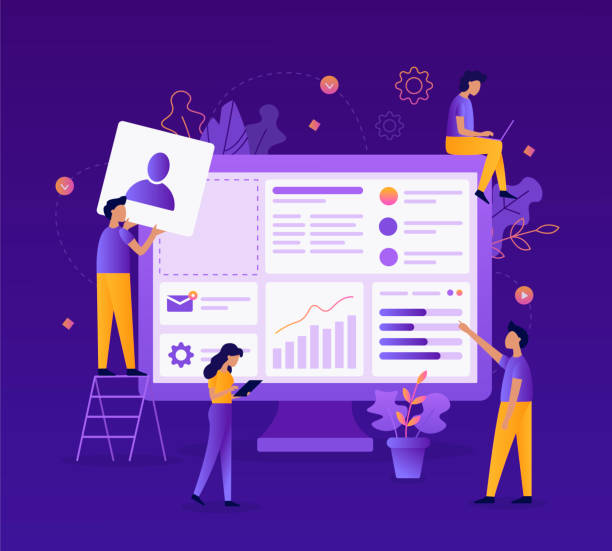
The process of e-commerce website design is a multi-stage and organized path, where each step has its own importance.
Disregarding any of these stages can lead to serious problems in the future and reduce the efficiency of your store.
The first and most important step is meticulous planning.
In this stage, business goals, target audience, products and services, budget, and timeline must be defined.
This stage also includes market research and competitor analysis to ensure the differentiation of your store.
After planning, it’s time for UI/UX design (User Interface and User Experience).
In this stage, the site structure, sitemap, wireframes, and finally the visual design of pages are created, focusing on ease of use and aesthetics.
The goal is to provide a smooth and pleasant user experience.
The next stage is technical development, where coding and implementation of store features are carried out based on the chosen platform.
This includes connection to payment gateways, inventory management system, and shipping systems.
After development, it’s time for testing and quality assurance.
In this stage, all functionalities, including the purchasing process, payment, product display, and website responsiveness across different devices, are carefully reviewed to identify and fix any errors or bugs.
Finally, it’s the launch and deployment stage of the website.
Even after launch, continuous monitoring and optimization are essential to ensure optimal performance and attract new customers.
Following these stages helps you to have an efficient and successful online store.
| Stage | Brief Description | Main Goal |
|---|---|---|
| Planning and Analysis | Defining goals, audience, competitors, and setting strategy | Creating a comprehensive and targeted roadmap |
| UI/UX Design | Creating wireframes, mockups, and visual design of the user interface | Ensuring excellent user experience and attractive appearance |
| Development and Coding | Technical implementation of features, connection to gateways and database | Building the technical and functional core of the site |
| Testing and Quality Assurance | Functional, security, and compatibility testing across various devices | Identifying and fixing errors before release |
| Launch and Support | Final site release and provision of support and maintenance services | Official launch and maintaining stability |
User Experience (UX) and User Interface (UI): The Cornerstone of E-commerce Website Design
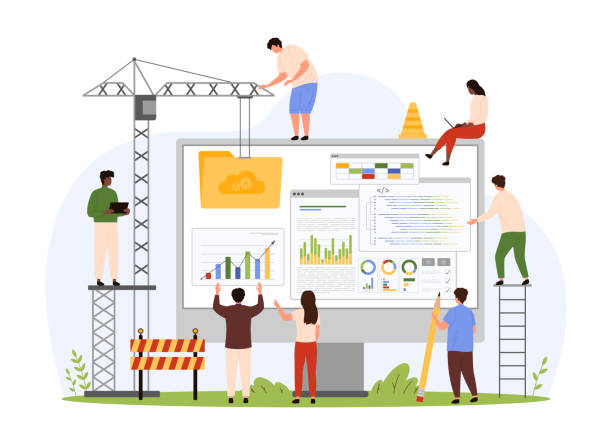
In the competitive world of e-commerce, merely having a website to sell products is not enough.
How users interact with your site, which includes User Experience (UX) and User Interface (UI), can make a big difference in the success of your store.
UI/UX design in e-commerce websites goes beyond visual aesthetics; it means creating a smooth and effortless path for customers so that they have a positive and enjoyable experience from the moment they enter the site until they complete their purchase.
An excellent UX ensures that users easily find the products they are looking for, obtain sufficient information about them, and complete the payment process without any issues.
This includes intuitive navigation design, efficient search, clear product pages, and a simple shopping cart.
On the other hand, UI refers to the look and feel of the site; colors, fonts, icons, and overall layout, which should be attractive, consistent, and aligned with your brand.
An attractive user interface is not only visually pleasing but also helps in visually guiding the user on the site.
Good UX/UI design leads to an increase in conversion rate (Conversion Rate), meaning a higher percentage of visitors convert into customers.
This also leads to increased customer trust and encourages their return for future purchases.
Ultimately, investing in effective UX/UI is essential for creating a business website that customers will like and trust, and it will play a direct role in your long-term success in the online space.
Does your current e-commerce website design lead to lost customers and sales?
Rasaweb, with its modern and user-friendly e-commerce website designs, is your solution!
✅ Significant increase in conversion rate and sales
✅ Unparalleled user experience for your customers
⚡ Click to get free consultation with Rasaweb!
How SEO for Online Stores Revolutionizes Your Sales?
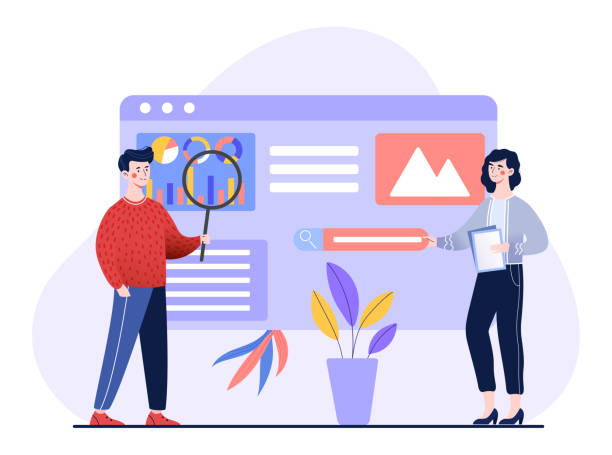
After the e-commerce website design stage and ensuring its proper functioning, the next challenge is customer acquisition.
This is where Search Engine Optimization (SEO) comes into play.
SEO for online stores is a set of techniques and strategies implemented with the aim of increasing your store’s visibility in Google and other search engine results.
Imagine a potential customer is looking for “gaming laptop purchase”; if your store does not appear on the first pages of search results, it will likely never be seen by that customer.
This is where the importance of SEO in e-commerce website design doubles.
Key SEO actions for an online store include targeted keyword research.
These keywords must be relevant to your products and be used by users in their searches.
Also, optimizing product descriptions using keywords, high-quality images, and attractive texts plays a significant role in attracting organic traffic.
Using Schema Markup to display richer information in search results (such as price, availability, and customer reviews) can also help increase the click-through rate.
SEO not only helps increase organic and targeted traffic but also leads to building credibility and trust for your brand, as users generally have more trust in top search results.
Ignoring SEO in e-commerce launch is like having a beautiful shop in a dead-end alley; no one will find it.
Therefore, SEO is a crucial component for your online sales success.
Security and Payment Gateways in E-commerce Website Design

One of the most important concerns for customers when shopping online is the security of their personal and financial information.
Therefore, security in e-commerce website design is considered a fundamental and non-negotiable principle.
A secure online store attracts customer trust and encourages them to complete the purchase process.
The first step to ensuring security is the use of an SSL certificate (Secure Sockets Layer).
This certificate encrypts the communication between the user’s browser and the website server and prevents the theft of sensitive information such as bank card details.
The presence of a green padlock next to the website address and “https” at the beginning of it indicates that SSL is active and the site is secure.
Choosing reliable and secure payment gateways is also vital.
In Iran, direct bank payment gateways like Shaparak, and intermediary payment gateways like Zarinpal and IDPay are common options, each with its own advantages and disadvantages.
Ensuring the payment gateway’s compliance with PCI DSS security standards is also essential.
Furthermore, special attention must be paid to protecting users’ personal information, such as name, address, and contact number.
Implementing strong firewalls, regular data backups, and continuous security updates are also among the important measures to maintain the security of an e-commerce platform.
Ignoring security can lead to loss of customers, damage to brand reputation, and even legal issues.
Therefore, a large part of the success in e-commerce website design depends on maintaining its security.
Maintenance, Updates, and Support After Launching the E-commerce Website

Many businesses assume that with the completion of e-commerce website design and its launch, the work is finished, but the truth is, this is just the beginning.
An online store, like a living organism, needs regular maintenance, continuous updates, and active support to be able to perform optimally and remain competitive in the market.
Neglecting these issues can lead to slow website performance, security vulnerabilities, incompatibility with new technologies, and ultimately, loss of customers.
Software updates, including CMS (Content Management System) updates, plugins, and themes, are essential for maintaining security and benefiting from the latest features.
Also, regular data backups to prevent data loss in case of unforeseen incidents is a crucial preventative measure.
Monitoring site performance, including loading speed, server response time, and resolving potential errors, significantly helps improve user experience.
In the realm of customer support, prompt and effective response to their questions and issues, via online chat, phone, or email, can lead to increased customer satisfaction and loyalty.
Furthermore, due to continuous changes in technology and user expectations, there may be a need to add new features, optimize the purchasing process, or improve the user interface to maintain a competitive advantage.
Active maintenance and support ensures that your e-commerce platform is always in its best condition and is ready to face future challenges.
| Activity Category | Examples and Descriptions | Importance |
|---|---|---|
| Software Updates | Updating CMS (WordPress, Magento), themes and plugins, updating PHP versions | Maintaining security, compatibility with new technologies, performance improvement |
| Data Backup | Regular backup of database, files, and product images | Preventing data loss in case of incidents |
| Performance Monitoring | Checking loading speed, server response time, traffic monitoring | Improving user experience, identifying performance issues |
| Security and Monitoring | Security scanning, log review, vulnerability patching | Preventing cyber attacks, protecting customer information |
| Database Optimization | Deleting redundant data, improving table structure | Increasing site speed and efficiency |
| Technical and Content Support | Answering technical questions, resolving user issues, managing new content | Maintaining customer satisfaction, keeping information up-to-date |
Common Challenges and Solutions in E-commerce Website Design

Despite the countless benefits of e-commerce website design, the path to launching and managing an online store is not without challenges.
Recognizing these obstacles and preparing to deal with them is key to long-term success.
One of the first and biggest challenges is intense competition in the online space.
With the increasing number of online stores, attracting customer attention and differentiating from competitors becomes more difficult.
The solution to this challenge is to offer a unique value proposition (UVP); whether through price, product quality, customer service, or an unparalleled shopping experience.
Another challenge is technical issues and implementation complexities.
Choosing an unsuitable platform, poor coding, and lack of optimization can lead to a slow, buggy, and insecure website.
Investing in a specialized team for online store development or collaborating with reputable e-commerce website design companies can overcome this challenge.
Inventory and logistics management is also a challenge for many businesses, especially on a large scale.
Implementing Inventory Management Systems (IMS) and collaborating with reliable shipping companies facilitates this process.
Marketing and traffic acquisition issues are also perpetual challenges.
Merely having a good website is not enough; traffic must be generated for it.
Using SEO strategies, content marketing, Pay-Per-Click (PPC) advertising, and social media marketing can help with this.
Finally, continuous changes in technology and customer expectations are also a permanent challenge, requiring continuous updates and adaptation of the online store.
Embracing these challenges as opportunities for growth and innovation leads to greater strengthening of your business in the e-commerce world.
Do you have an e-commerce site, but your sales aren’t what you expected? Rasaweb, with its professional e-commerce website designs, solves your problem forever!
✅ Significant increase in conversion rate and sales
✅ Unparalleled user experience for your customers
⚡ Click to get free consultation with Rasaweb!
The Future of E-commerce Website Design and Emerging Trends
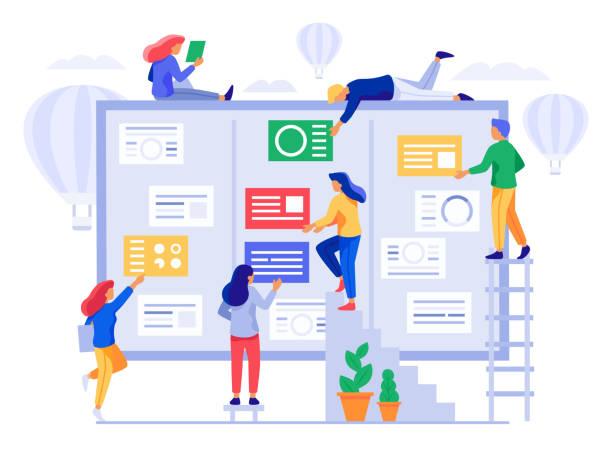
The world of e-commerce is constantly evolving, and e-commerce website design is no exception.
New trends and emerging technologies are rapidly reshaping the way online buying and selling are done.
Understanding these trends and being prepared to embrace them is essential for any business seeking sustainability and growth in the future.
One of the most important future trends is deeper personalization of the shopping experience.
By using Artificial Intelligence (AI) and Machine Learning (ML), stores can create much more accurate product recommendations, customized offers, and even completely unique user experiences for each customer.
Augmented Reality (AR) and Virtual Reality (VR) experiences are also entering the world of e-commerce and allow customers to virtually see products in their real environment or examine them in 3D, which can reduce return rates and increase customer trust.
Voice Commerce and voice search are also expanding, and websites must be optimized to respond to these types of interactions.
Social Commerce and live streams are also gaining increasing popularity, and deeper integration of the store with social platforms will be essential.
Furthermore, emphasis on sustainability and transparency in the supply chain is among the factors that customers will pay more attention to in the future.
Businesses that consider these trends in their e-commerce website design will not only lead the competition but also keep pace with changing consumer expectations and innovatively meet their needs.
Investing in E-commerce Website Design: A Strategic and Smart Decision
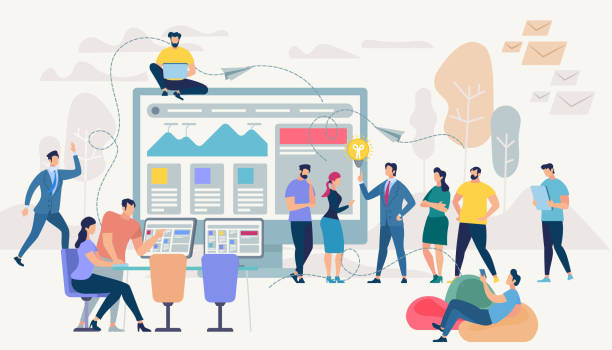
In conclusion, it can be concluded that e-commerce website design is not an additional cost, but a strategic and vital investment for the survival and growth of any business in the digital age.
This investment opens a gateway to new markets, countless opportunities for development, and provides a powerful tool for increasing efficiency and profitability.
A professional online store enables you to transcend the time and spatial limitations of a physical business and reach a global audience.
This means operating 24 hours a day, 7 days a week, without the need for a permanent physical presence.
By optimizing sales processes and automating many operations, you can significantly reduce your costs and direct resources towards more key activities.
Furthermore, data and analyses from online store performance provide valuable insights into customer behavior, product performance, and opportunities for improvement, which will be very effective in future strategic decisions.
In today’s world, where consumers have turned to online shopping more than ever, not having a powerful e-commerce platform means losing a large market share and falling behind competitors.
Therefore, whether you are a small startup or a large, established company, investing in quality e-commerce website design tailored to your needs is a smart decision that guarantees the foundation of your success and sustainable development in the coming years.
This step is not just an operational change, but a fundamental transformation in your business’s approach to the market and customers.
Frequently Asked Questions
| Question | Answer |
|---|---|
| What is e-commerce website design? | The process of designing and developing a website for selling products or services online to customers. |
| Why is responsive design important for an e-commerce website? | To ensure that the site is displayed correctly and with a good user experience on all devices (mobile, tablet, desktop). |
| What are the key features of a successful e-commerce website? | Comprehensive product catalog with details, user-friendly shopping cart, secure and easy payment process, ability to manage orders and user accounts. |
| How long does it take to design an e-commerce website? | It depends on the complexity, number of features, and project scope, but usually ranges from a few weeks to several months. |
| How much does e-commerce website design cost? | The cost varies based on requested features, design type (ready-made template or custom), platform used, and the design company or freelancer. |
And other services of Rasaweb Advertising Agency in the field of advertising
Smart UI/UX: Revolutionize SEO ranking with the help of marketing automation.
Smart Direct Marketing: A combination of creativity and technology for campaign management through custom programming.
Smart Conversion Rate Optimization: A new service for improving SEO ranking through marketing automation.
Smart Data Analysis: A combination of creativity and technology for digital branding through custom programming.
Smart Data Analysis: A quick and efficient solution for campaign management focusing on marketing automation.
And over a hundred other services in the field of internet advertising, advertising consultation, and organizational solutions.
Internet Advertising | Advertising Strategy | Advertorial
Resources
The Importance of E-commerce Website Design in Online Businesses
The Vital Role of E-commerce Websites in Business Progress
The Future of Businesses with E-commerce Website Design
Why E-commerce Website Design is Essential for Modern Businesses?
? In today’s competitive world, a strong online presence is the key to success. Rasaweb Afarin Digital Marketing Agency, by providing comprehensive services including fast website design, SEO, and social media management, brings your business to its peak. For free consultation and to learn more about our services, contact us today. 021-91097325
📍 Tehran, Mirdamad Street, next to Central Bank, Southern Kazerun Alley, Ramin Alley, No. 6

